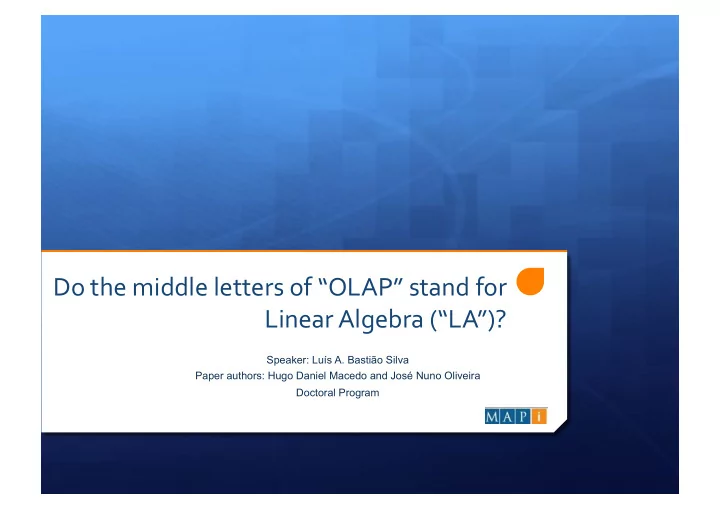

Do#the#middle#letters#of#“OLAP”#stand#for# Linear#Algebra#(“LA”)? ! Speaker: Luís A. Bastião Silva Paper authors: Hugo Daniel Macedo and José Nuno Oliveira Doctoral Program
Summary# ! Motivation ! Goals ! Background ! Cross tabulations in LA ! Higher-dimensional OLAP ! Conclusion and future work 2#
Motivation • Nowadays, companies are creating a huge amount of data • Big data trend • They need to access to the information stored in these databases and calculate some metrics • OLAP (Online Analytical Processing): • Summarize huge amount of information • Forms of histograms, sub-totals, cross tabulations, roll-up/drill down, data cubes • Expensive task (computationally) 3!
Motivation • Perform data mining and online analytical processing (OLAP) in a efficient way • OLAP is : • Resource-demanding • Calls for parallelization • OLAP operations: • Pivot • Roll-up • Cube 4!
Related work • Ng. et al develop a collection of parallel algorithms to data cube construction in low cost PCs (Clustering) • PARSIMONY: provides a parallel and scalable infrastructure for multidimensional analyses • There are commercial solutions like Oracle and IBM that also implement their parallel algorithms • This paper propose a new direction: OLAP and data mining should rely on Linear Algebra 5!
Cross tabulation • Provides a summary of a data extracted from raw source • Example: • How many vehicles sold per colour and model? 6!
Cross tabulation • How many vehicles sold per colour and model? • Selected Color and Model as attributes and Sales as a measure • Answer is: In!this!paper:!solve!this!problem!with!Linear!Algebra.! 7! But!how!we!can!parallelize?!!!!
OLAP - Cube • Cross tabulation summaries: • Computationally expensive • Long time (large datasets) • OLAP cube compute all dimensions • Calculate all possible options • Summarize the table • Works like a cache of values • Easy to compute and access data in time 8!
Cross tabulation – Linear Algebra • Three matrices: • Two associated with dimensions (attributes) – A and B • Measure or Metric • Divide-and-conquer principle, with matrix multiplication: • OLAP cross-tabulation can be expressed by: • A, B is dimensions and M is the measure 9!
Cross tabulation – Linear Algebra 10!
Cross tabulation – Linear Algebra 11!
Rolling-up on functional dependences • Rolling-up means replacing a dimension by another which is more general in some sense (eg. grouping, classification, containment). • Also works for checking functional dependences 12!
Rolling-up on functional dependences • Rolling-up means replacing a dimension by another which is more general in some sense (eg. grouping, classification, containment). • Also works for checking functional dependences 13!
Rolling-up on functional dependences • Rolling-up means replacing a dimension by another which is more general in some sense (eg. grouping, classification, containment). • Also works for checking functional dependences 14!
Incremental construction • Cross tabulations defined by Linear Algebra is amenable to incremental constructions OLAP Cube Pivot Table (Yesterday) (Today ) OLAP Cube (Tomorrow) • Advantage: is not necessary to build all the CUBE every single day! 15!
Higher#dimensionality#@#OLAP## ! Consider#n@dimensions:#aggregate,#group@by,#cross# tabulations#and#cube# ! Generalization#based#on#Khatri@Rao#product# ! Works#like#a#Cartesian#product# ! Khatri@Rao#product:# 16!
Higher-dimensional OLAP • All dimensions • Whole dimension part • Raw-data table • The Khatri-Roa of: • tModel and tColor 17!
Higher-dimensional OLAP • All dimensions • Whole dimension part • Raw-data table 18!
Higher-dimensional OLAP • All dimensions • Whole dimension part • Raw-data table 19!
Conclusion and future work • OLAP computationally problematic • Parallelization is already possible, but not with linear algebra • Encoding OLAP in concepts of Linear Algebra – formal method • Rely on theory of parallel sparse matrix/matrix multiplication to achieve parallelism • Cross tabulation is incremental • Future: • Extending LA for other OLAP features • Implement in Multi-core and GPU and replace the OpenOffice/ 20! LibreOffice pivot table calculator
Future work (GPGPU) 21!
Questions?# 22!
Recommend
More recommend